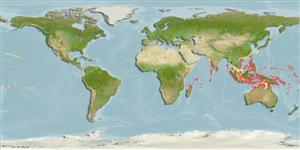>
Gobiiformes (Gobies) >
Gobiidae (Gobies) > Gobiinae
Etymology: Callogobius: Greek, kalos, kallos = beautiful + Latin, gobius = gudgeon (Ref. 45335); maculipinnis: Named for Dr. Richard Van Cleve, then Acting Director of the University of Washington School of Fisheries..
More on author: Fowler.
Issue
Junior synonym Intonsagobius vanclevei is valid according to Delventhal & Mooi, 2013 (Ref. 93174:156 as Callogobius vanclevei).
Environment: milieu / climate zone / depth range / distribution range
Écologie
marin récifal; profondeur 3 - 37 m (Ref. 86942). Tropical; 30°N - 15°S
Indo-Pacific: Red Sea south to Bazaruto (Ref. 2798) and eastward to Samoa; north to the Ryukyu Is., the Philippines, Guam and the Marshall Islands.
Taille / Poids / Âge
Maturity: Lm ? range ? - ? cm
Max length : 6.8 cm TL mâle / non sexé; (Ref. 2798)
Description synthétique
Clés d'identification | Morphologie | Morphométrie
Épines dorsales (Total) : 7; Rayons mous dorsaux (Total) : 9; Épines anales: 1; Rayons mous anaux: 7. Characterized by brown or yellowish brown with scattered pale brown spots on side of body; usually with four diffuse brown bars (below first dorsal, anterior second dorsal, anterior caudal peduncle and on caudal fin base), wavy oblique brown bands on dorsal fins; light and dark spots on all fins except pelvics; dorsal spines tips usually forming short filaments; completely united pelvic fins with well-developed frenum; rounded caudal fin; longitudinal scale series 22-25; cycloid scales on nape, pectoral fin base and breast, becoming ctenoid posteriorly; cheek and opercle with embedded cycloid scales; predorsal scales 6-7; head with prominent papillae ridges; depth of body 4.0 in SL (Ref. 90102).
Occurs among corals.
Life cycle and mating behavior
Maturities | Reproduction | Spawnings | Egg(s) | Fecundities | Larves
Myers, R.F., 1991. Micronesian reef fishes. Second Ed. Coral Graphics, Barrigada, Guam. 298 p. (Ref. 1602)
Statut dans la liste rouge de l'IUCN (Ref. 130435)
Menace pour l'homme
Harmless
Utilisations par l'homme
Outils
Articles particuliers
Télécharger en XML
Sources Internet
Estimates based on models
Preferred temperature (Ref.
123201): 26.9 - 29, mean 28.1 °C (based on 438 cells).
Phylogenetic diversity index (Ref.
82804): PD
50 = 0.5000 [Uniqueness, from 0.5 = low to 2.0 = high].
Bayesian length-weight: a=0.00708 (0.00333 - 0.01504), b=3.09 (2.92 - 3.26), in cm total length, based on LWR estimates for this (Sub)family-body shape (Ref.
93245).
Niveau trophique (Ref.
69278): 3.2 ±0.3 se; based on size and trophs of closest relatives
Résilience (Ref.
120179): Haut, temps minimum de doublement de population inférieur à 15 mois (Preliminary K or Fecundity.).
Fishing Vulnerability (Ref.
59153): Low vulnerability (10 of 100).
Nutrients (Ref.
124155): Calcium = 184 [81, 378] mg/100g; Iron = 0.923 [0.449, 1.819] mg/100g; Protein = 17.9 [15.9, 19.6] %; Omega3 = 0.101 [0.043, 0.201] g/100g; Selenium = 27.2 [12.0, 64.9] μg/100g; VitaminA = 124 [32, 452] μg/100g; Zinc = 2.37 [1.50, 3.57] mg/100g (wet weight);
